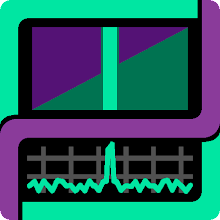
The red spectral plot of the Average window shows a strong tone at -469 kHz and two weaker tones at around -2 MHz. The slopes on the left and right of the red Average spectral curve are from filters in the sampling unit or from a digital down conversion (DDC) process. The slight negative slope (-0.5 dB over 6 MHz) of the spectral curve is interesting, I'd expect it to be symmetrical around 0 Hz but it could be because this chuck of spectrum was extracted from a wider section of bandwidth.
The green spectrogram plot shows that these tones are stationary for the one second file duration which is not long enough to determine if they are stationary or are drifting. I need to look at the larger 1.9 GB data file, that is still downloading, to know for sure. Looks like there might be some modulation but that could just be the noise. The tones are fairly weak signals and further analysis is required.
The histogram on the right shows that sample data has a Gaussian distribution which is to be expected from radio telescope data. The histogram is centered at zero and it doesn't have any skew which is good.
This one second test data file was streamed into baudline's standard input. The data format is 2-channel quadrature signed 8-bit samples. The sample rate was calculated by dividing the one second file size by 2 to be 8738133 samples/seconds. Here is the command line used:
cat 2010-04-02-amc7-3693.4464-8bit-one-second.dat | baudline -session setiquest -stdin -format s8 -channels 2 -quadrature -samplerate 8738133 -pause
So join setiQuest, download baudline, and start analyzing signals today.

1 comment:
Nice to hear from you again.
It's pretty fascinating what baudline can be used for.
Is there a reason why there hasn't been a baudline update for some years?
Post a Comment